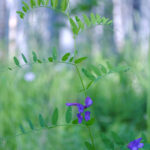American Vetch
Vicia americana Muhl. ex Willd.
General Description
American vetch is a long-lived, cool season, native perennial legume. It has climbing or trailing tendrils; the name vicia is from the Latin vincio meaning to bind or climb. It is commonly found throughout British Columbia. Its common names include American vetch, wild vetch, stiff-leaf vetch, and wild pea. Currently recognized subspecies are Vicia americana ssp. americana and Vicia americana ssp. minor Hook.
Type
Native legume.
Origin
Native to North America.
Longevity
Long-lived.
Use
Reclamation, pasture. American vetch is used as a nitrogen-fixing cover crop, as a legume in native seed mixtures for revegetating disturbed areas, and for wildlife and livestock grazing. First Nations used the leaves for poultices, and the pods and seeds for food.
Optimal Time of Use
Summer.
Recovery After Use
Not tolerant to heavy or continuous grazing; decreases with overgrazing.
Palatability/Nutritional Value
Low yielding but valuable forage for grazing both wildlife (mule deer, grizzly bear, black bear, small mammals, game birds) and livestock (cattle, sheep, horses).
Annual Precipitation min/max (mm)
230mm / 1270mm
Drought Tolerance
High tolerance.
Flooding Tolerance
Is not tolerant of saturated soils or flooding.
Winter Hardiness
Considered winter hardy where it is adapted in the lowland, steppe, and montane zones.
Soil Texture Preference
Prefers fine or clay soils to medium-textured or loamy soils. It prefers moist to dry soils and full sun.
Erosion Control
Some erosion control value if established.
Salinity Tolerance
No tolerance to moderate tolerance. Ecotype variance should be expected.
Acidity Tolerance
Low tolerance, tolerates pH levels down to 5.9.
Alkalinity Tolerance
Low tolerance, up to pH 7.2.
Seeds per kg
72,230 seeds/kg (32,763 seeds/lb)
Suggested Mixtures
In pasture situations, can be mixed with a taller-growing grass or fall rye so that it can climb. Should be mixed with other suitable native species for native plant community restoration, or where native species are desired.
Ease of Establishment
Scarification (scratching or etching) of the seed will decrease the germination time from 14 to 7 days but will not improve overall germination. Spring or fall seeding. Low seedling vigour.
Competitiveness
Can be very competitive in some environments.
Management Considerations
Managed grazing is required to maintain American vetch in the plant community.
BC Rangeland Seeding Manual, USDA Plants Database
American vetch is common in deciduous forests in the Sub-Boreal Spruce and Sub-Boreal Pine-Spruce zones. In the southern part of the region it is found with trembling aspen in the Bunchgrass zone and in deciduous forests in the Interior Douglas-fir zone.
American vetch is common in fescue grasslands (upper elevation Bunchgrass) and deciduous forests in the Interior Douglas-fir zones.
American vetch is found in native plant communities throughout the Peace-Liard region, common in meadows and open forest.
